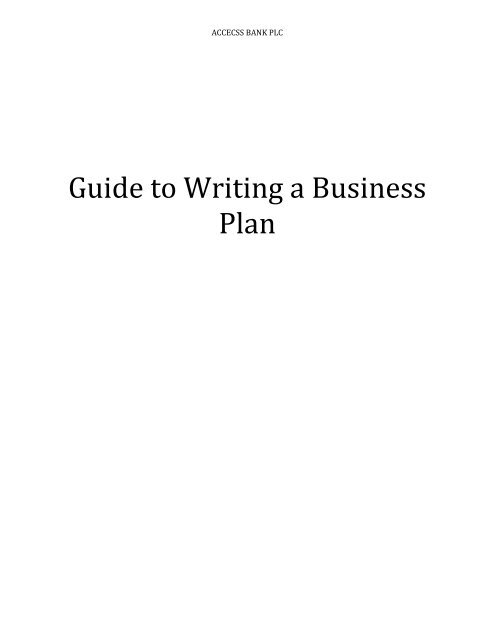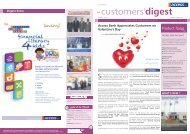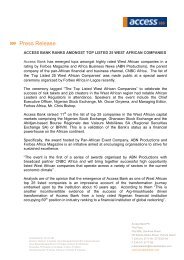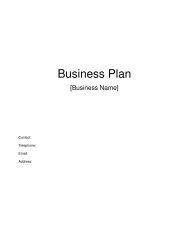Guide to W riting a Business Plan - Access Bank
Guide to W riting a Business Plan - Access Bank
Guide to W riting a Business Plan - Access Bank
You also want an ePaper? Increase the reach of your titles
YUMPU automatically turns print PDFs into web optimized ePapers that Google loves.
Introduction<br />
When starting a company, a business plan can help you <strong>to</strong> set the desired targets, put your plans<br />
for raising funds in good perspective, collate all your ideas and plans, and verify that your idea for<br />
a business is realistic and achievable.<br />
Formulating a business plan is one of the most important tasks when starting up a new business<br />
and reviewed regularly, will enable the moni<strong>to</strong>ring of the business <strong>to</strong> quickly spot problem areas,<br />
measure performance and ultimately, achieve the set goals.<br />
The guide will help you understand:<br />
1. What a business plan should include<br />
2. How you should go about w<strong>riting</strong> one<br />
3. What you will achieve by doing so<br />
It includes hints and tips as well as other information for businesses in both start-up and growth<br />
phases.<br />
Benefits<br />
The business plan will help you:<br />
• Collate your ideas, research and all other analysis in a structured format<br />
• Decide whether or when your business will be commercially viable<br />
• <strong>Plan</strong> the strategy <strong>to</strong> be adopted for your business and predict the point where you will break<br />
even<br />
• Set targets and objectives, including sales and financial targets, so you can moni<strong>to</strong>r your<br />
business performance regularly.<br />
• Clarify your business purpose, vision, mission and core objectives<br />
• Using the well defined SWOT analysis <strong>to</strong> predict future scenarios and pitfalls and address them<br />
in a timely manner<br />
How <strong>to</strong> approach the plan<br />
Your business plan may be a proposal intended for use <strong>to</strong> attract financing for your business. In<br />
this case, it is imperative that you understand the core values and objectives of the intended<br />
inves<strong>to</strong>r(s) and put them in<strong>to</strong> consideration when drawing up the plan.<br />
Please note that the scenarios depicted in the plan need <strong>to</strong> be realistic and yet convince intended<br />
financiers that the business can thrive, and ultimately be successful. You must consider what<br />
evidence is available <strong>to</strong> back up all your claims.<br />
Importantly, you should have a distinctive plan which should be easy <strong>to</strong> read, comprehensive yet<br />
concise and very factual.<br />
You must also identify what you want <strong>to</strong> communicate externally about you and your business.<br />
State the assumptions you have made in reaching your conclusions, clearly stating some<br />
important facts such as the market research which determined your sales, your choice of location
and other assumptions on which the plan is based, the inves<strong>to</strong>r will have a clear picture of your<br />
plan and this will aid an informed decision concerning investment.<br />
Be honest, clear, articulate and believable. Also importantly, pay attention <strong>to</strong> details.<br />
Format & Content of a <strong>Business</strong> <strong>Plan</strong><br />
Most business plans will differ, but there are basic steps/content headers which will help ensure<br />
that your plan captures all the important aspects of the proposed business. This will also provide<br />
insight which may be required for a financier <strong>to</strong> make a decision.<br />
1. Executive Summary<br />
2. Table of Contents<br />
3. Aims and Objectives; Vision and Mission<br />
4. <strong>Business</strong> Description<br />
5. Legal Structure<br />
6. Management processes<br />
7. Market Trend Analysis<br />
8. Marketing Strategy<br />
9. Marketing <strong>Plan</strong><br />
10. Sales strategy, targets and objectives<br />
11. Operational Requirements<br />
12. Financial Requirements and Forecasts<br />
13. Training Requirements<br />
14. <strong>Business</strong> Risks<br />
15. PEST and SWOT Analysis<br />
16. Appendices<br />
1. Executive Summary<br />
This is the introduction <strong>to</strong> the <strong>Business</strong> <strong>Plan</strong>.<br />
It should be a brief summary of the <strong>to</strong>tal picture and the first thing that will be read. It must thus<br />
be concise, provoke interest and as mentioned earlier, stand out from most business.<br />
You must be able <strong>to</strong> state clearly:<br />
• What makes your business idea, product, service or marketing plan unique or original<br />
• What gives you an edge over identified competition<br />
• What experience you and your team have in the intended line of business that will show<br />
that you are capable of making it succeed.<br />
• How you have demonstrated that your business will be viable, remain a going concern, and<br />
be profitable.<br />
• How and when the financier/lender will get their money back<br />
• How the inves<strong>to</strong>r(s) will earn an attractive return if/when you eventually sell the business or<br />
buy back their shares.
2. Tables of Contents<br />
This should list the main sections and page numbers in the plan and should lead the reader<br />
through the contents. The plan should be easy <strong>to</strong> navigate and should contain the required<br />
information <strong>to</strong> generate a reaction and response from the reader(s).<br />
3. Aims and Objectives; Vision and Mission<br />
Most people start up a business with the aim of having a degree of independence and/or<br />
creating the opportunity <strong>to</strong> generate a reasonable income.<br />
However, you should know what your motivating fac<strong>to</strong>r is. The following questions, if answered<br />
satisfac<strong>to</strong>rily, will give you a better insight which will then be translated <strong>to</strong> the plan.<br />
• Why are you going in<strong>to</strong> business<br />
• What do you plan <strong>to</strong> achieve?<br />
• Will income from the business be your sole or additional income?<br />
• Are your ownership plans for the business short, medium or long term i.e. are you starting<br />
the business as an investment, <strong>to</strong> sell as soon as you can?<br />
The answers <strong>to</strong> these questions, amongst others, will shape your business by helping you<br />
highlight the aims and objectives, business development and strategy.<br />
They will also help define and articulate the vision and mission of your business, and determine<br />
how you will go about achieving these goals as your business commences.<br />
4. <strong>Business</strong> Description<br />
Be very specific about the type of business you are starting.<br />
Begin by defining the specifics of the business, bearing in mind that the intended target<br />
segment will determine or be determined by this. For instance, if you have chosen <strong>to</strong> open a<br />
clothing s<strong>to</strong>re, do you want <strong>to</strong> sell clothing that are couture, casual, business, or specifically for<br />
children? Do you want <strong>to</strong> sell clothes for men only, women only or both genders?<br />
How will your products and services differ from those offered by competition? Why would<br />
cus<strong>to</strong>mers choose <strong>to</strong> buy from you? How will you give your business the edge necessary for it<br />
<strong>to</strong> be, and remain successful?<br />
You should describe your business like you are w<strong>riting</strong> a mission statement which should<br />
clearly summarise the purpose of your business, and be perfectly unders<strong>to</strong>od by all parties;<br />
you, your staff and potential inves<strong>to</strong>rs.<br />
5. Legal Structure<br />
What is the proposed legal structure of your business?<br />
Will it be a sole proprie<strong>to</strong>rship, partnership or limited liability company? The chosen structure<br />
will affect your tax and other management processes, thus impacting on your cash flow.<br />
Inves<strong>to</strong>rs may also be concerned about the legal status of the business and the impact on<br />
liability, and you need <strong>to</strong> be sure that you have chosen the most appropriate legal structure in<br />
line with your business objectives.
Do you need licences before you can start your business? You should exhibit knowledge of the<br />
licenses you need <strong>to</strong> apply for and the steps you have taken <strong>to</strong> do so. Licenses are required for<br />
the hospitality businesses, childcare businesses and importation businesses, <strong>to</strong> mention a few.<br />
6. Management Processes<br />
How will your business be managed?<br />
Organization is important as this will make the running of your business easier <strong>to</strong> manage.<br />
Even for a sole proprie<strong>to</strong>r, it is important <strong>to</strong> understand your key skills, responsibilities and<br />
management processes at this stage. You will need <strong>to</strong> consider the following fundamental<br />
areas:<br />
• Marketing and sales<br />
• Finance.<br />
• Recruitment and HR<br />
• Product development<br />
• Administration<br />
You will also need <strong>to</strong> develop a plan <strong>to</strong> moni<strong>to</strong>r and track performance (against set objectives<br />
and targets), and <strong>to</strong> co-ordinate the roles of all staff whose functions will impact on this.<br />
7. Market Trend Analysis<br />
What is your target market and where is it located?<br />
If well forecasted, and in order <strong>to</strong> earn enough revenue, your business must be able <strong>to</strong> capture<br />
a healthy share of the target market. You will need <strong>to</strong> have a thorough understanding of your<br />
market <strong>to</strong> do this, including its size and the share you can realistically achieve. These will be<br />
influenced by:<br />
• The <strong>to</strong>tal size of the market<br />
• The current and forecasted market trend<br />
You also need <strong>to</strong> research the market situation in relation <strong>to</strong> your potential cus<strong>to</strong>mers and your<br />
competi<strong>to</strong>rs and explain your conclusion.<br />
8. Marketing Strategy<br />
How many cus<strong>to</strong>mers do you hope will buy from you, and during which period?<br />
Once you have developed a clear understanding of your market, it’s easier <strong>to</strong> define your<br />
overall marketing strategy. Break this down in<strong>to</strong> objectives and targets relating <strong>to</strong> volume,<br />
market segments and share you hope <strong>to</strong> achieve. Also include the timelines for achievement.<br />
For example:<br />
• Who is your target segment?<br />
• Why have you chosen this segment?<br />
• What products and/or services will you offer <strong>to</strong> them?<br />
• What is your Unique Selling Proposition (USP) and how does this differentiate you from<br />
competition?
• What is the projected volume, value or share of these markets?<br />
• What are the target dates for achieving these targets?<br />
• Will your target segment change? If yes, which will be your next in six months or a year<br />
for instance?<br />
9. Marketing <strong>Plan</strong><br />
How will you carry out your marketing?<br />
Once you have a clear marketing strategy, you need <strong>to</strong> be clear about how you are going <strong>to</strong><br />
make it happen and clearly understand the four ‘P’s (product, price, promotion and place).<br />
A detailed marketing plan should explain how you will go about achieving each of your<br />
marketing targets and objectives (as defined in your marketing strategy above).<br />
Such a plan will include some or all of the following:<br />
• The marketing methods you will use for each segment of your target market.<br />
• The specific action you are going <strong>to</strong> take <strong>to</strong> reach each segment.<br />
• Timelines for each marketing activity.<br />
• Your marketing budget<br />
• How you will handle positive or negative response <strong>to</strong> your marketing.<br />
10. Sales Strategy, Targets & Objectives<br />
What are your sales targets and how will you achieve them?<br />
Set out your forecasts in terms of:<br />
• Sales of different product types by volume and count.<br />
• Sales from different target segments or location<br />
• Sales from different distribution channels.<br />
11. Operational Requirements<br />
What do you need <strong>to</strong> start? In other words, how will you set your operational plans in<br />
motion?<br />
Details about your operational requirements will be essential when preparing your financial<br />
forecasts, while other information will be needed for basic operational planning.<br />
Estimate the expected costs by outlining your plans for the following aspects of your<br />
business:<br />
1. Premises<br />
2. Equipment<br />
3. Staffing<br />
4. Licensing & other approvals<br />
5. Insurance<br />
6. Suppliers & distribu<strong>to</strong>rs<br />
7. Compliance & other regula<strong>to</strong>ry issues
12. Financial Requirements and Forecasts<br />
How much money do you need and for what purpose? Your business plan should include a<br />
breakdown of your financial requirements, the sources of finance you have available <strong>to</strong> you<br />
and any additional finance you may require. This should include:<br />
• The cost of starting your business<br />
• Your personal budget.<br />
• Details about your personal financing for the business<br />
• Details of additional financing<br />
• A break-even analysis<br />
• A detailed cash flow forecast<br />
• A profit-and-loss forecast <strong>to</strong> help you estimate when your business will start <strong>to</strong> make<br />
a profit.<br />
• A balance sheet forecast <strong>to</strong> provide you with a snapshot of the trading position of<br />
your business.<br />
13. Training Requirements<br />
Draw up a plan for required training, including details of the following:<br />
1. Relevant training courses you have attended<br />
2. Training needs that you or your employees have or anticipate<br />
This will help you identify any skills gaps, and make plans <strong>to</strong> address them. It will also<br />
assist in budgeting for training costs in your cash flow forecast.<br />
14. <strong>Business</strong> Risks<br />
You have <strong>to</strong> consider all the risks and plot the mitigating fac<strong>to</strong>rs. What could go wrong?<br />
Project what the worst case scenario is, and what will you do in that situation.<br />
Your plan should include an honest assessment of all the risks involved in your business,<br />
as well as how you will minimise them. This is important because you need <strong>to</strong> have<br />
considered all possible outcomes, put plans in place <strong>to</strong> mitigate them and be prepared <strong>to</strong><br />
deal with any outcome.<br />
The table will help you itemize all risks and the measure <strong>to</strong> be taken <strong>to</strong> avoid them.<br />
Risks<br />
Mitigants<br />
15. PEST & SWOT Analysis<br />
PEST is an acronym for political, economic, social and technological, and provides a<br />
framework for reviewing your business in the light of external fac<strong>to</strong>rs that may affect it in the
future. By being aware of trends and impending advances in the outside world, your<br />
business can gain a competitive edge. You may also be able <strong>to</strong> identify fresh opportunities<br />
or forthcoming dangers <strong>to</strong> be aware of the marketplace.<br />
Also, the strengths, weaknesses, opportunities and threats (SWOT) process helps you<br />
focus on the internal fac<strong>to</strong>rs – strengths and weaknesses, and the external fac<strong>to</strong>rs –<br />
opportunities and threats that impact on your business.<br />
A SWOT grid, as shown below will help you focus on your business strategy and anticipate<br />
the issues you may encounter.<br />
Strengths<br />
Weakness<br />
Opportunities<br />
Threats<br />
16. Appendices<br />
<br />
The first page of the appendix should list all the documents it contains so they can be found<br />
easily by anyone reading the plan. The documents and their location in the appendix should<br />
also be referenced in the main body of the business plan.<br />
The appendix should include all the documents that support the plan as a whole, or specific<br />
headers, for example:<br />
• Your CV and those of your business partners and/ or key employees<br />
• Certificates for relevant training courses.<br />
• Copies of a lease for any business premises you will be renting.<br />
• Market research data.<br />
• Financial information, etc
















